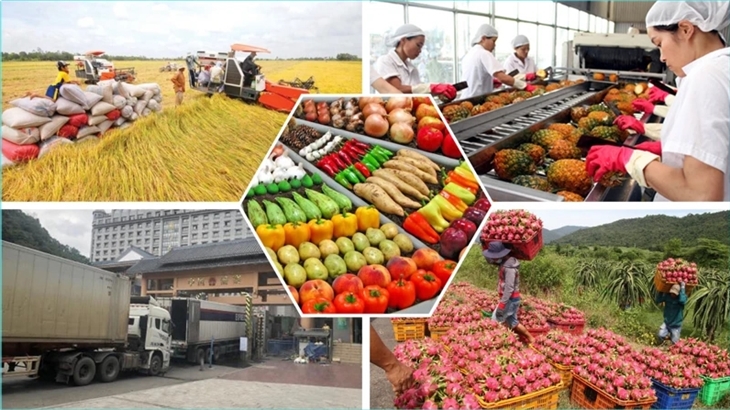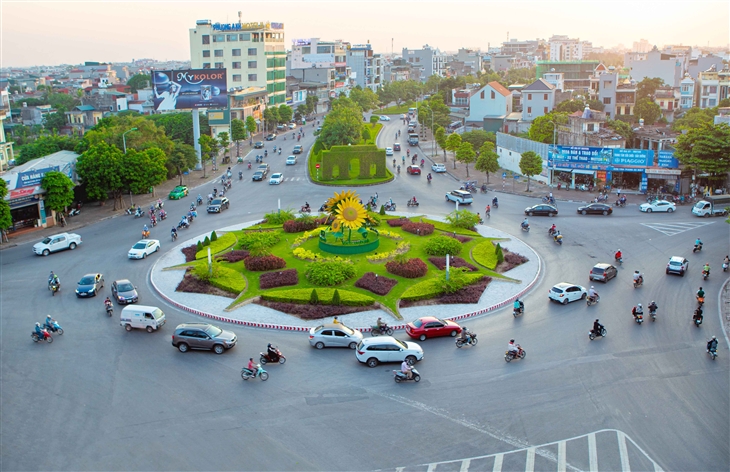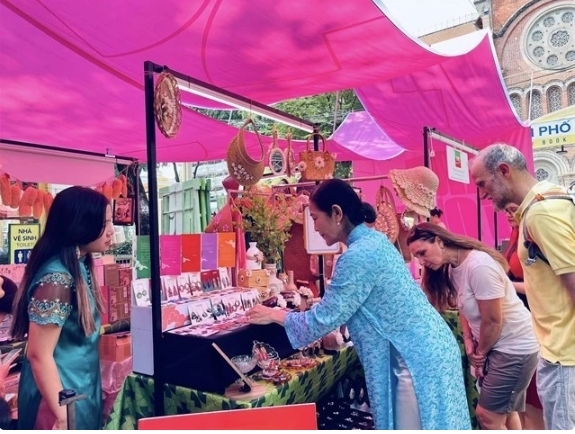Exploiting billion-dollar market from agricultural by-products
Friday, June 13,2025
AsemconnectVietnam - Rice bran and seafood by-products can bring in billions of dollars each year from exports if businesses know how to take advantage of, promote processing and meet market demands.
Ready to meet market demands
After a long time being considered a by-product with no high value in the rice production industry, however, in mid-April 2025, Ministry of Agriculture and Environment of Vietnam and General Administration of Customs of China officially signed the Protocol on safety requirements and quarantine of animals and plants for rice bran and rice bran extracts exported to China, opening up new opportunities for this product.
The export of rice bran and rice bran extracts not only brings economic benefits but also motivates the Vietnamese agricultural sector to improve production quality, promote investment in processing technology, protect the environment and optimize the value of rice by-products.
As an enterprise exporting rice bran to the Chinese market, speaking with reporters of the Industry and Trade Newspaper, Ms. Huynh Tuyet Nghi - Director of Honoroad Vietnam Rice Bran Processing Company Limited - said that each year, the company exports about 150,000 tons of rice bran, of which 100% of the output is consumed in the Chinese market. Vietnamese enterprises are fully capable of meeting the strict requirements on product quality set forth by China within framework of the Protocol.
Sharing the same view, Mr. Nguyen Van Thanh - Director of Phuoc Thanh IV Production - Trading Company Limited (Vinh Long province) - said that the demand for rice bran and extracted rice bran products for animal feed is very large. Therefore, the signing of the Protocol will contribute to expanding the output market for by-products from Vietnamese rice.
Although the conditions for exporting rice bran and extracted rice bran to the Chinese market are not easy due to strict requirements on quarantine and food safety. However, in recent times, businesses have become familiar with these requirements. Therefore, Vietnam has enough potential to turn the above item into one of the key export items.
Not only rice bran, in the field of seafood, the potential from waste products is huge. Leading the field of collagen and gelatin production from pangasius skin is Vinh Hoan Joint Stock Company. According to the representative of this enterprise, the production of collagen and gelatin from fish skin helps Vinh Hoan Company optimize costs and profits when utilizing by-products in the production process of the core product, pangasius fillets. Accordingly, instead of being discarded, fish skin is used as an input material to produce collagen and gelatin.
Talking to reporters of the Industry and Trade Newspaper, Dr. Duong Nghia Quoc - Chairman of the Vietnam Pangasius Association - said that pangasius by-products including heads, bones, skin, fins, red meat, belly flaps and stomachs are currently utilized to produce fishmeal for the production of animal feed for export to the Chinese market; Fish oil is processed into food or cosmetic ingredients.
The export turnover of these products can reach billions of USD, but this figure has not been included in the total export turnover of the pangasius industry. If added together, we can earn 3-4 billion USD from exporting this item.
Market pressure will be the driving force for businesses to change
According to estimates from the Ministry of Agriculture and Environment, Vietnam currently has 170 - 180 million tons of agricultural by-products each year. If left unused, it will be a source of pollution, on the contrary, if collected and processed, it will not only bring in foreign currency but also bring the ability to offset carbon instead of buying credits, because the products created from by-products can reduce carbon the most.
1 kg of shrimp costs only 20 USD but 1 kg of chitosan (a by-product extracted from shrimp) can cost up to 500 USD. Mr. Phan Thanh Loc - Chairman of the Board of Directors of Vietnam Food - pointed out that it is estimated that shrimp by-products can create 20-30 times more value if applied to the pharmaceutical industry, or 15-20 times more if applied to functional foods.
According to experts, currently, the seafood by-product processing industry in Vietnam has only reached about 275 million USD/year, if exploited well, this source of raw materials can generate 4-5 billion USD/year. The ability to create added value from seafood by-products in Norway helps products increase 28 times compared to input. This figure in Vietnam has only stopped at 2-3 times.
Affirming that the market potential for agricultural by-products is very large. However, to take advantage of this effectively, businesses need to have enough resources to invest in technology and improve economic efficiency in processing value-added products.
For rice bran, although there is no official data on the global market, experts predict that this figure could reach tens of billions of USD. The opportunity for Vietnamese rice bran in the world market in general and China in particular is huge.
However, according to Ms. Huynh Tuyet Nghi, the biggest difficulty in exporting rice bran and rice bran extract to the Chinese market today is not in the export products but in the administrative procedures. Specifically, businesses are currently facing many challenges in promptly grasping updated information on regulations and procedures between the two countries, especially when these requirements can change frequently and lack consistency.
Notably, the time from completing the packaging stage to when the ship arrives at the Chinese port is only about 3 - 4 days. This creates great pressure, requiring businesses to complete all export procedures and documents in a short time to avoid delays or customs clearance rejections.
According to Mr. Pham Kim Dang - Deputy Director of the Department of Animal Husbandry and Veterinary Medicine (Ministry of Agriculture and Environment), in order to access and develop sustainably in the Chinese market, Vietnamese rice bran and rice bran extract exports must meet very strict standards according to the provisions of the Protocol. The success of rice bran exports depends largely on the seriousness and responsibility of businesses.
Vietnam's agriculture and fisheries are entering a transparent game. Along with opening the market, promoting deep processing of agricultural by-products will bring billions of dollars in revenue to the agricultural and fisheries industries. Mr. Le Son Ha - Head of Plant Quarantine Department, Plant Protection Department (Ministry of Agriculture and Environment) - also noted that factories need to improve their facilities and production processes to meet HACCP standards. A business that does not comply can lead to high storage and warehousing costs or even be banned from exporting, causing damage to the whole industry.
“The seafood industry has applied HACCP standards since the 2000s to help meet the strict requirements of the international market. Market pressure will be the driving force for change. If we cannot meet them, we will lose export opportunities. The way the seafood industry does things will also be an experience for businesses exporting rice bran to the Chinese market,” said Mr. Le Son Ha.
Source: Vitic/ congthuong.vn
After a long time being considered a by-product with no high value in the rice production industry, however, in mid-April 2025, Ministry of Agriculture and Environment of Vietnam and General Administration of Customs of China officially signed the Protocol on safety requirements and quarantine of animals and plants for rice bran and rice bran extracts exported to China, opening up new opportunities for this product.
The export of rice bran and rice bran extracts not only brings economic benefits but also motivates the Vietnamese agricultural sector to improve production quality, promote investment in processing technology, protect the environment and optimize the value of rice by-products.
As an enterprise exporting rice bran to the Chinese market, speaking with reporters of the Industry and Trade Newspaper, Ms. Huynh Tuyet Nghi - Director of Honoroad Vietnam Rice Bran Processing Company Limited - said that each year, the company exports about 150,000 tons of rice bran, of which 100% of the output is consumed in the Chinese market. Vietnamese enterprises are fully capable of meeting the strict requirements on product quality set forth by China within framework of the Protocol.
Sharing the same view, Mr. Nguyen Van Thanh - Director of Phuoc Thanh IV Production - Trading Company Limited (Vinh Long province) - said that the demand for rice bran and extracted rice bran products for animal feed is very large. Therefore, the signing of the Protocol will contribute to expanding the output market for by-products from Vietnamese rice.
Although the conditions for exporting rice bran and extracted rice bran to the Chinese market are not easy due to strict requirements on quarantine and food safety. However, in recent times, businesses have become familiar with these requirements. Therefore, Vietnam has enough potential to turn the above item into one of the key export items.
Not only rice bran, in the field of seafood, the potential from waste products is huge. Leading the field of collagen and gelatin production from pangasius skin is Vinh Hoan Joint Stock Company. According to the representative of this enterprise, the production of collagen and gelatin from fish skin helps Vinh Hoan Company optimize costs and profits when utilizing by-products in the production process of the core product, pangasius fillets. Accordingly, instead of being discarded, fish skin is used as an input material to produce collagen and gelatin.
Talking to reporters of the Industry and Trade Newspaper, Dr. Duong Nghia Quoc - Chairman of the Vietnam Pangasius Association - said that pangasius by-products including heads, bones, skin, fins, red meat, belly flaps and stomachs are currently utilized to produce fishmeal for the production of animal feed for export to the Chinese market; Fish oil is processed into food or cosmetic ingredients.
The export turnover of these products can reach billions of USD, but this figure has not been included in the total export turnover of the pangasius industry. If added together, we can earn 3-4 billion USD from exporting this item.
Market pressure will be the driving force for businesses to change
According to estimates from the Ministry of Agriculture and Environment, Vietnam currently has 170 - 180 million tons of agricultural by-products each year. If left unused, it will be a source of pollution, on the contrary, if collected and processed, it will not only bring in foreign currency but also bring the ability to offset carbon instead of buying credits, because the products created from by-products can reduce carbon the most.
1 kg of shrimp costs only 20 USD but 1 kg of chitosan (a by-product extracted from shrimp) can cost up to 500 USD. Mr. Phan Thanh Loc - Chairman of the Board of Directors of Vietnam Food - pointed out that it is estimated that shrimp by-products can create 20-30 times more value if applied to the pharmaceutical industry, or 15-20 times more if applied to functional foods.
According to experts, currently, the seafood by-product processing industry in Vietnam has only reached about 275 million USD/year, if exploited well, this source of raw materials can generate 4-5 billion USD/year. The ability to create added value from seafood by-products in Norway helps products increase 28 times compared to input. This figure in Vietnam has only stopped at 2-3 times.
Affirming that the market potential for agricultural by-products is very large. However, to take advantage of this effectively, businesses need to have enough resources to invest in technology and improve economic efficiency in processing value-added products.
For rice bran, although there is no official data on the global market, experts predict that this figure could reach tens of billions of USD. The opportunity for Vietnamese rice bran in the world market in general and China in particular is huge.
However, according to Ms. Huynh Tuyet Nghi, the biggest difficulty in exporting rice bran and rice bran extract to the Chinese market today is not in the export products but in the administrative procedures. Specifically, businesses are currently facing many challenges in promptly grasping updated information on regulations and procedures between the two countries, especially when these requirements can change frequently and lack consistency.
Notably, the time from completing the packaging stage to when the ship arrives at the Chinese port is only about 3 - 4 days. This creates great pressure, requiring businesses to complete all export procedures and documents in a short time to avoid delays or customs clearance rejections.
According to Mr. Pham Kim Dang - Deputy Director of the Department of Animal Husbandry and Veterinary Medicine (Ministry of Agriculture and Environment), in order to access and develop sustainably in the Chinese market, Vietnamese rice bran and rice bran extract exports must meet very strict standards according to the provisions of the Protocol. The success of rice bran exports depends largely on the seriousness and responsibility of businesses.
Vietnam's agriculture and fisheries are entering a transparent game. Along with opening the market, promoting deep processing of agricultural by-products will bring billions of dollars in revenue to the agricultural and fisheries industries. Mr. Le Son Ha - Head of Plant Quarantine Department, Plant Protection Department (Ministry of Agriculture and Environment) - also noted that factories need to improve their facilities and production processes to meet HACCP standards. A business that does not comply can lead to high storage and warehousing costs or even be banned from exporting, causing damage to the whole industry.
“The seafood industry has applied HACCP standards since the 2000s to help meet the strict requirements of the international market. Market pressure will be the driving force for change. If we cannot meet them, we will lose export opportunities. The way the seafood industry does things will also be an experience for businesses exporting rice bran to the Chinese market,” said Mr. Le Son Ha.
Source: Vitic/ congthuong.vn
FDI increased sharply in first 5 months of 2025
Pepper prices soar by more than 60%, exports surge
Consumer price index increased slightly in May
7 commodity groups with export value of billions of USD in May
Exporting fruits and vegetables to China: Choosing quality for long haul
Pepper exports increased sharply in value, decreased in volume
Vietnam's import-export and trade balance in first 5 months of 2025
Top 5 localities with the highest industrial production index
Rice exports in first 5 months of 2025
Vietnam’s industrial index in first 5 months of 2025
Agricultural, forestry and fishery exports and imports: situation and measures to facilitate
Challenges and measures to promote Vietnam's imports and exports
Nam Dinh industrial production increased by 29.16% in 5 months of 2025
3 highlights of Vietnam's manufacturing industry in May

Plan of Hai Duong province for a period of 2021 - 2030, ...
Organize space reasonably and harmoniously, focusing on connecting Hai Duong in common development space, actively contributing to the ...Plan of Hau Giang province in a period of 2021 - 2030, ...
Sustainable forestry development program in a period of ...

Art programme honouring Ao dai opens at HCM City Book ...
An art programme to honour and promote traditional cultural values and the beauty and grace of Ao dai has opened in Ho Chi Minh City. It ...From Hanoi to Brussels – a cross-cultural musical journey
Talented youngsters to enjoy int'l football ...
Tien Linh, Thuy Trang win Vietnam Golden Ball 2024
HCM City’s ao dai festival to feature mass folk dance with ...



